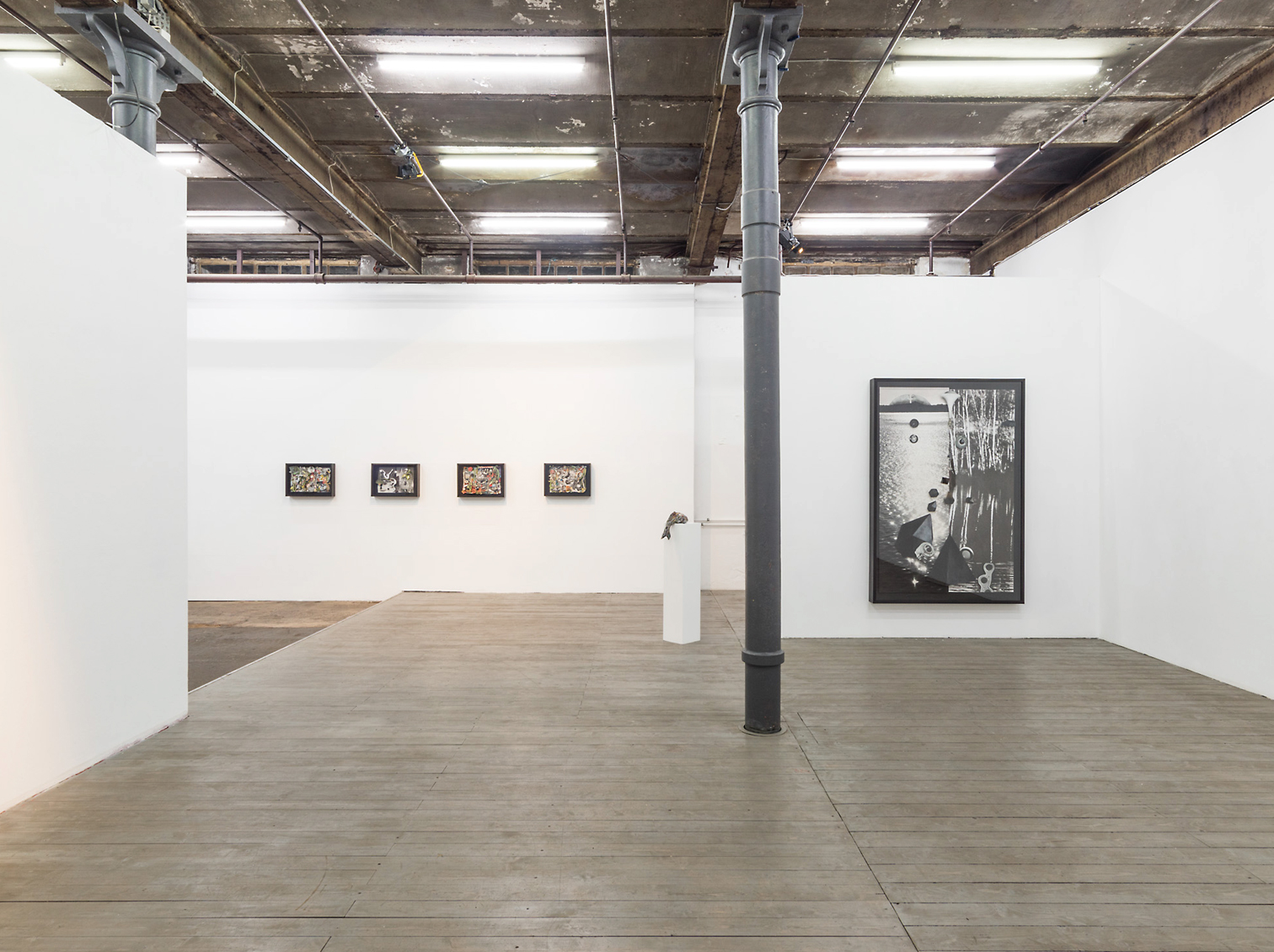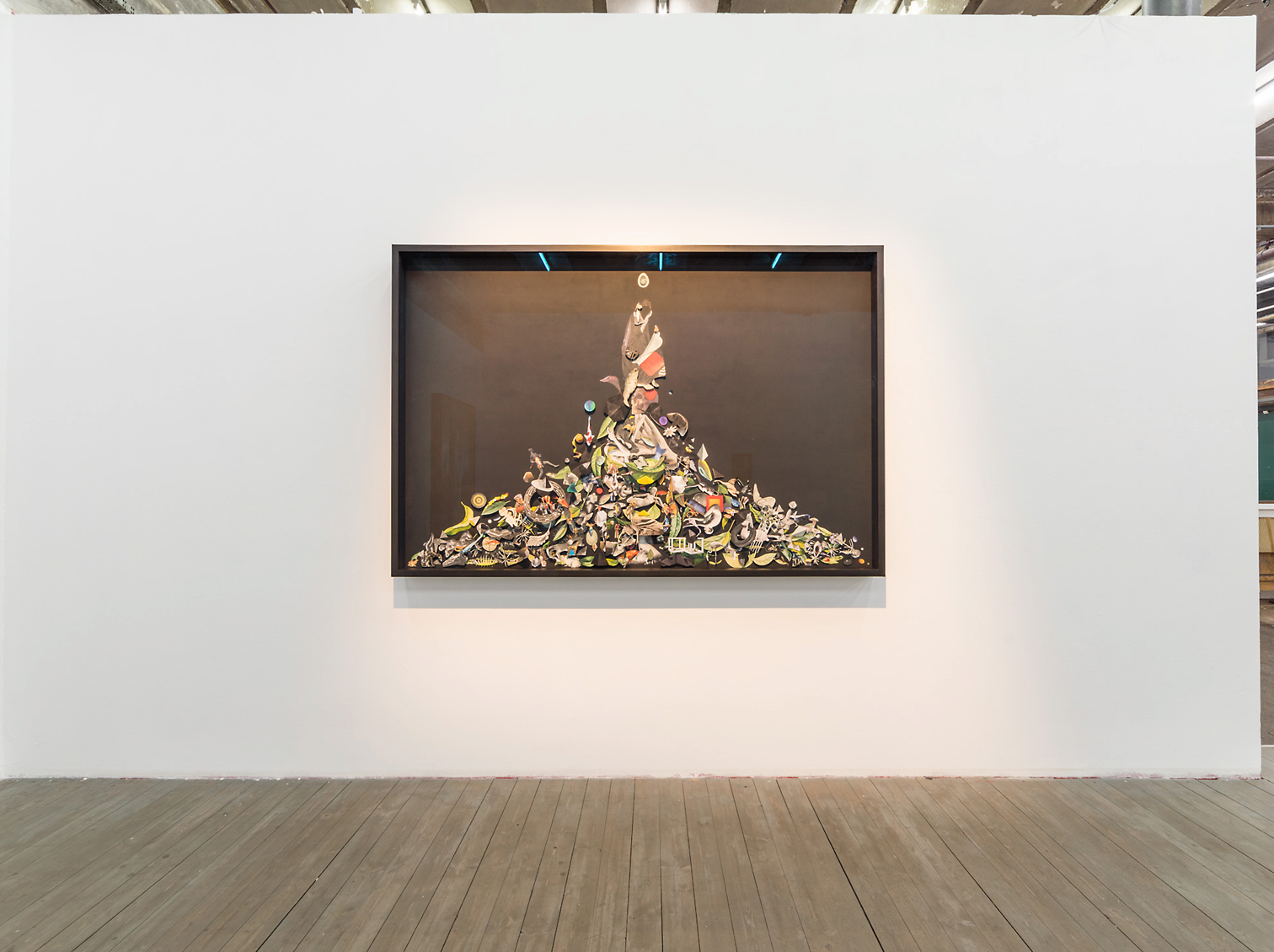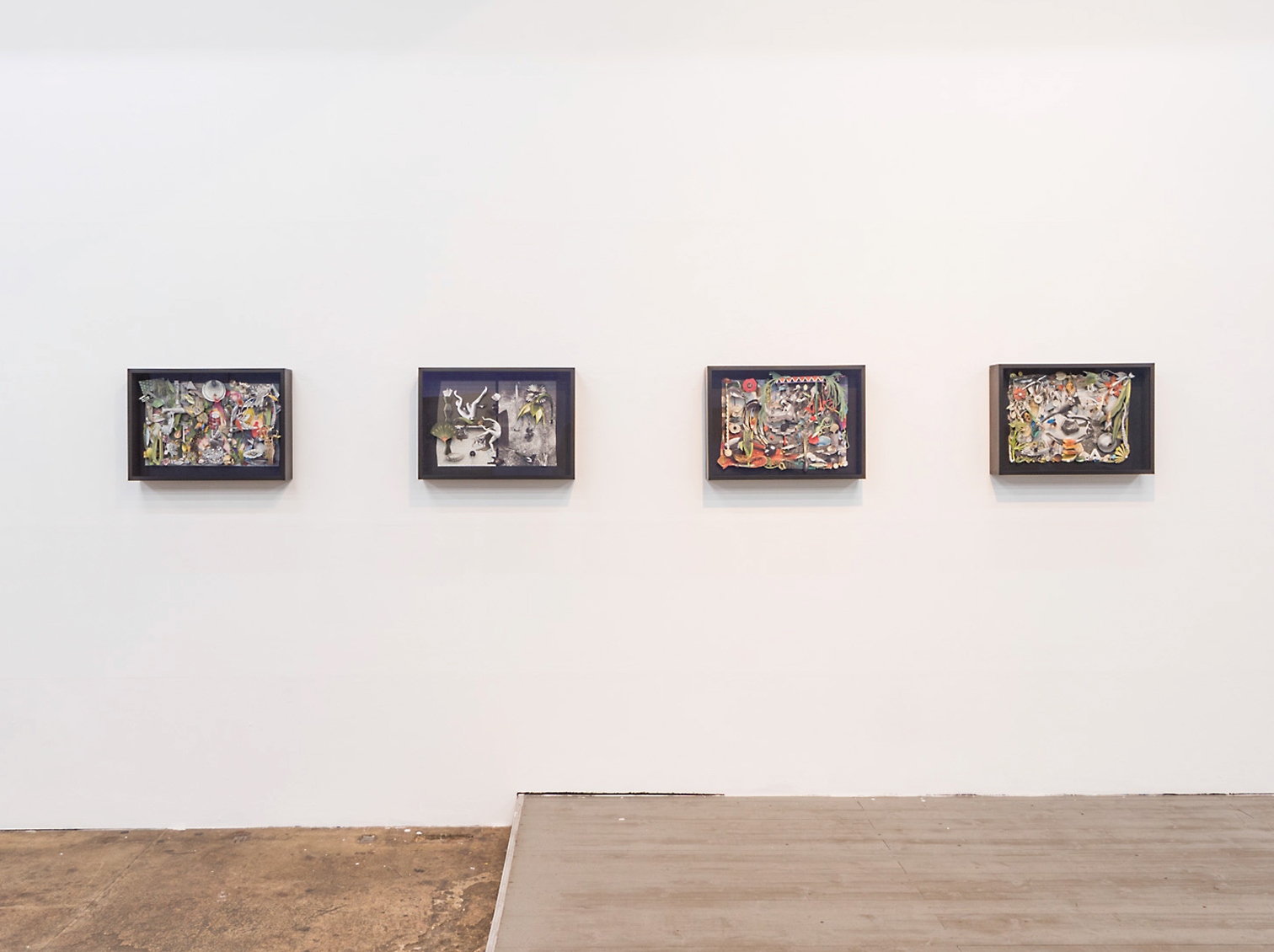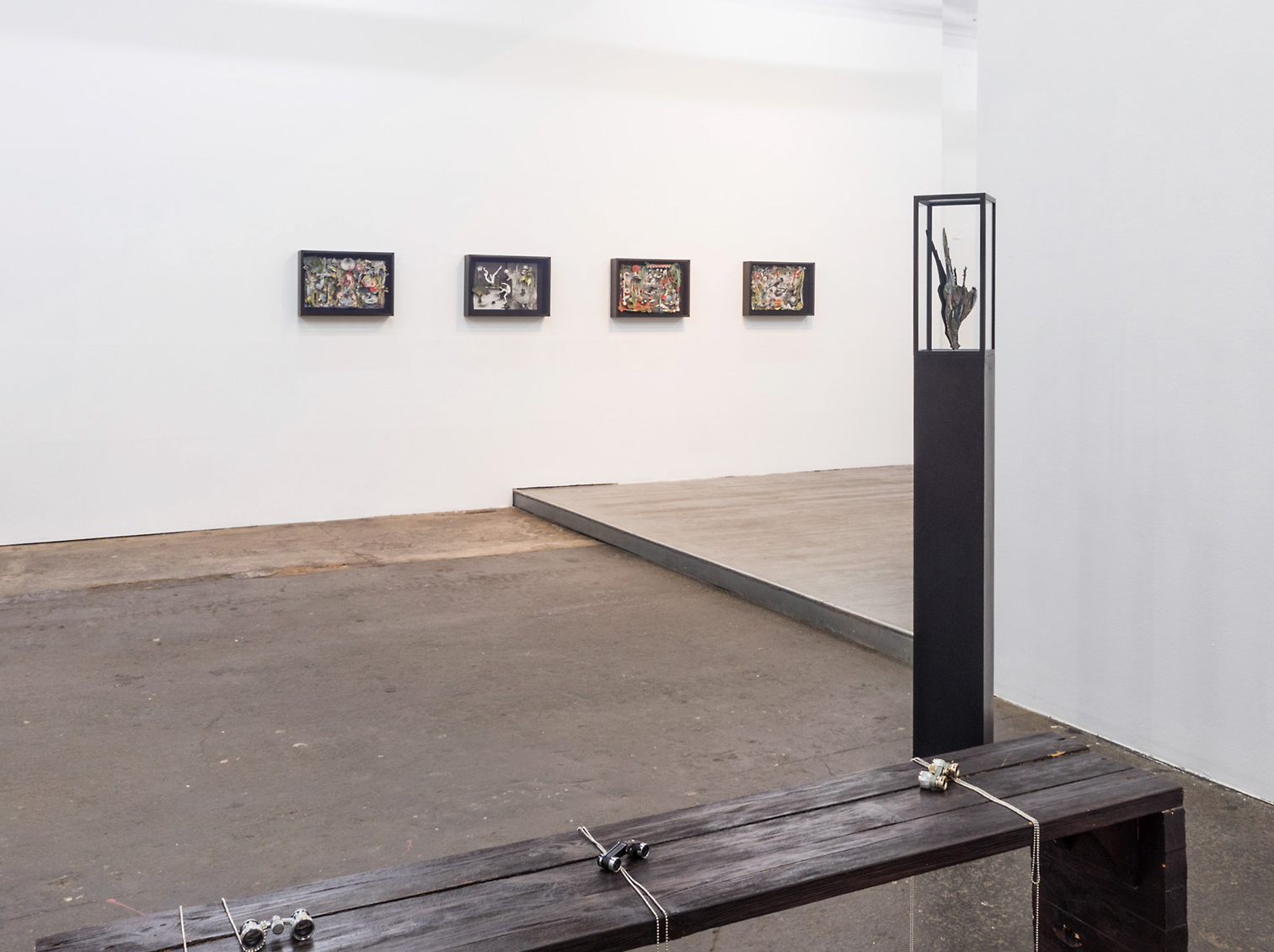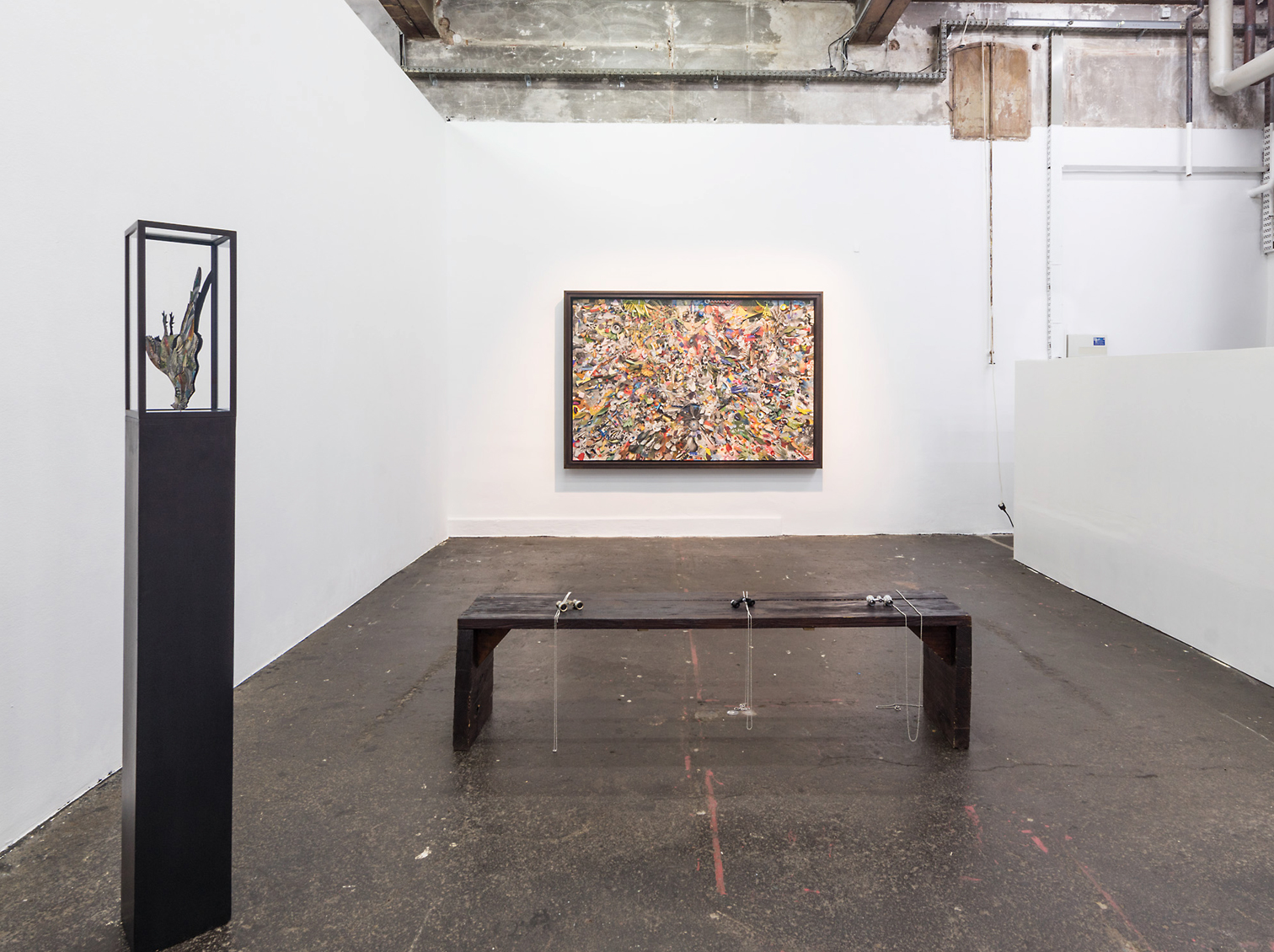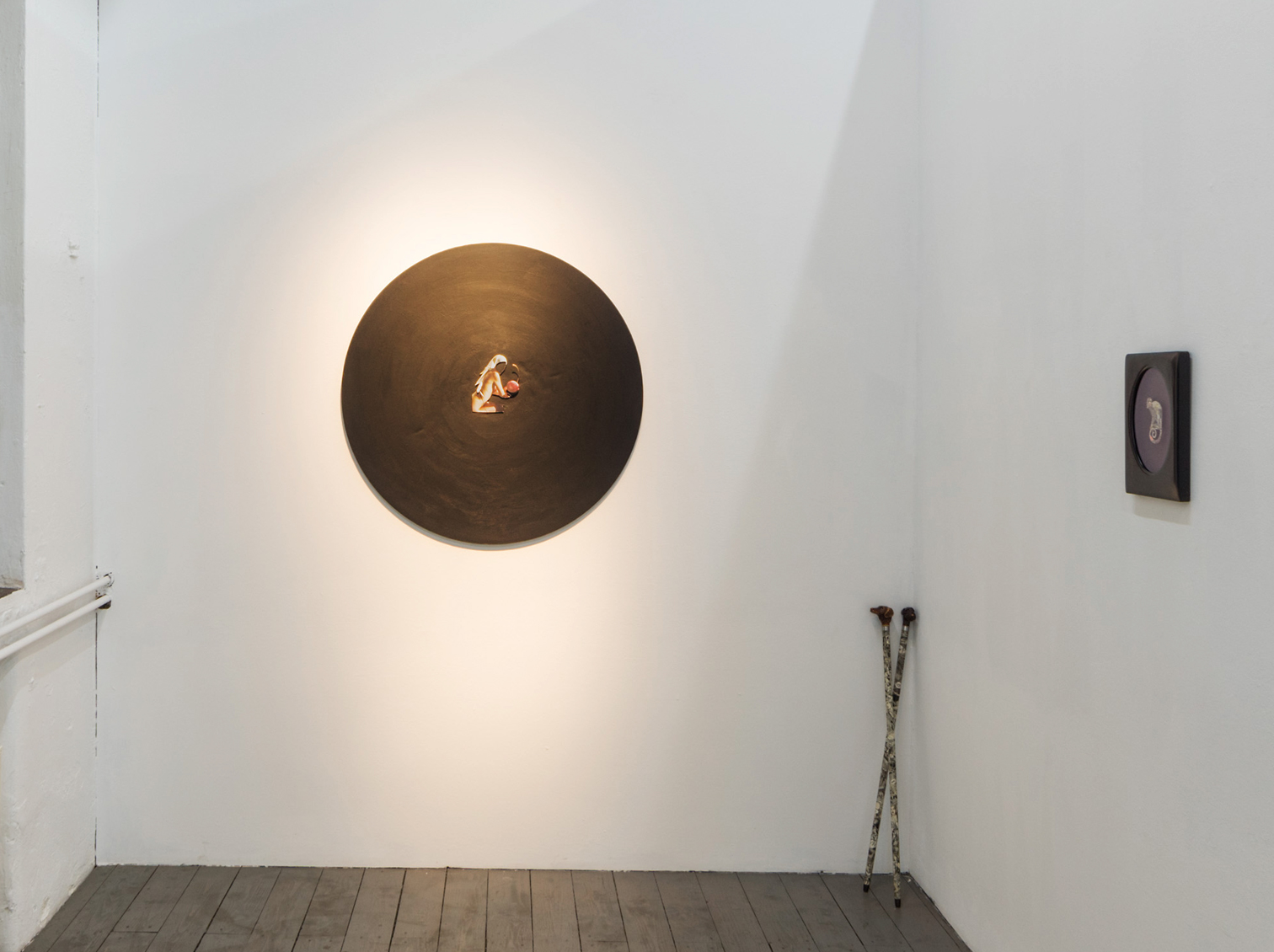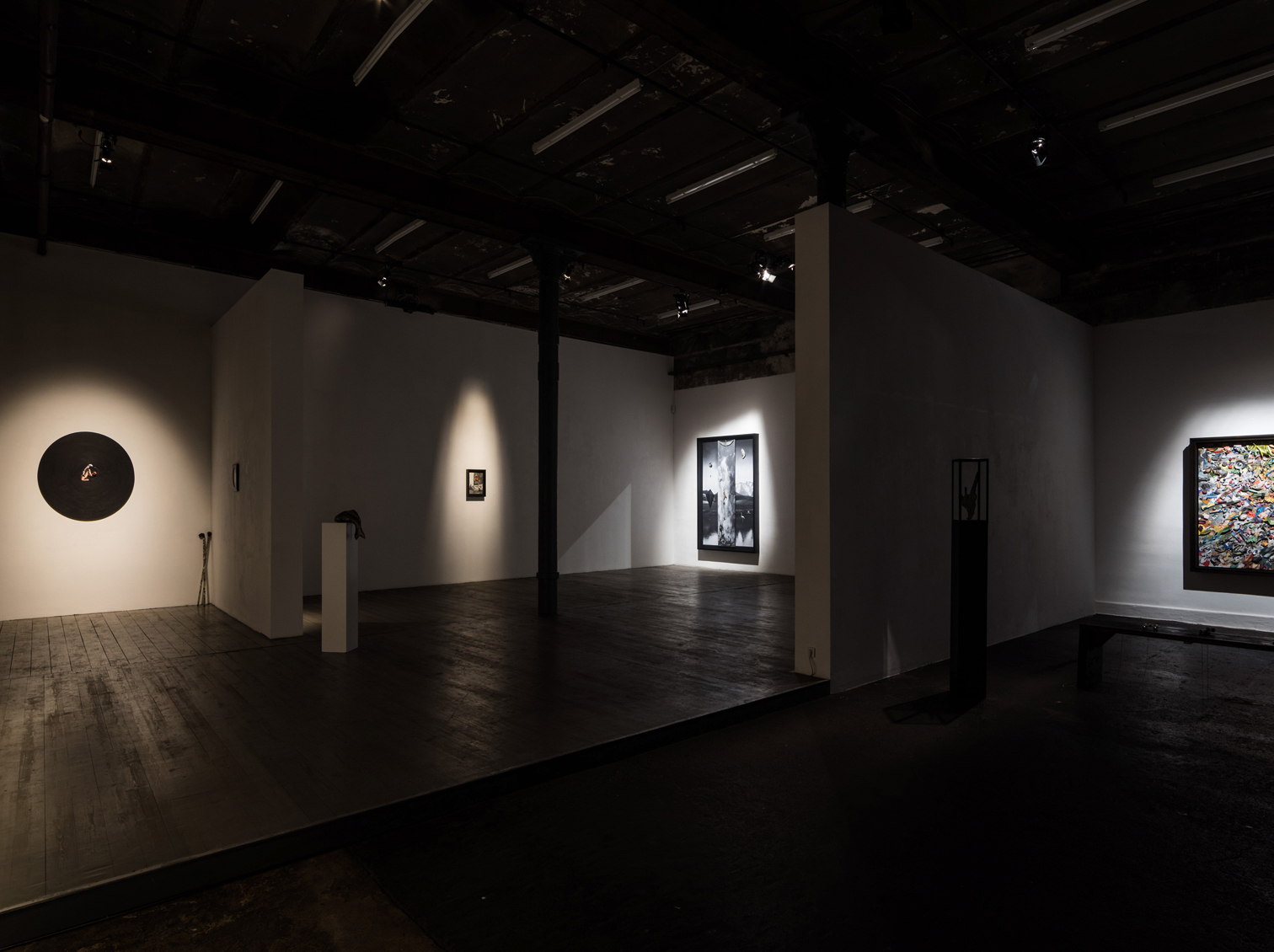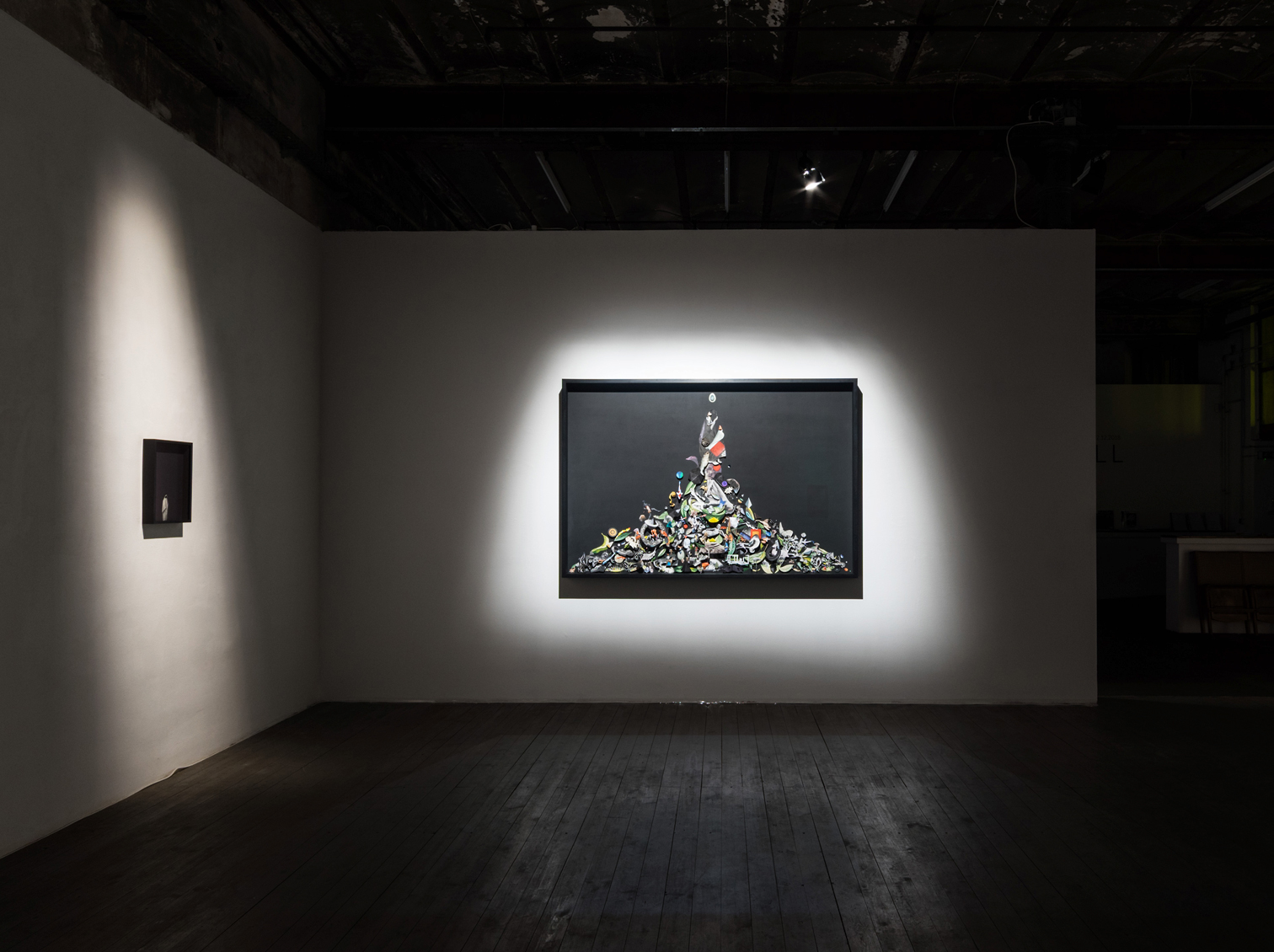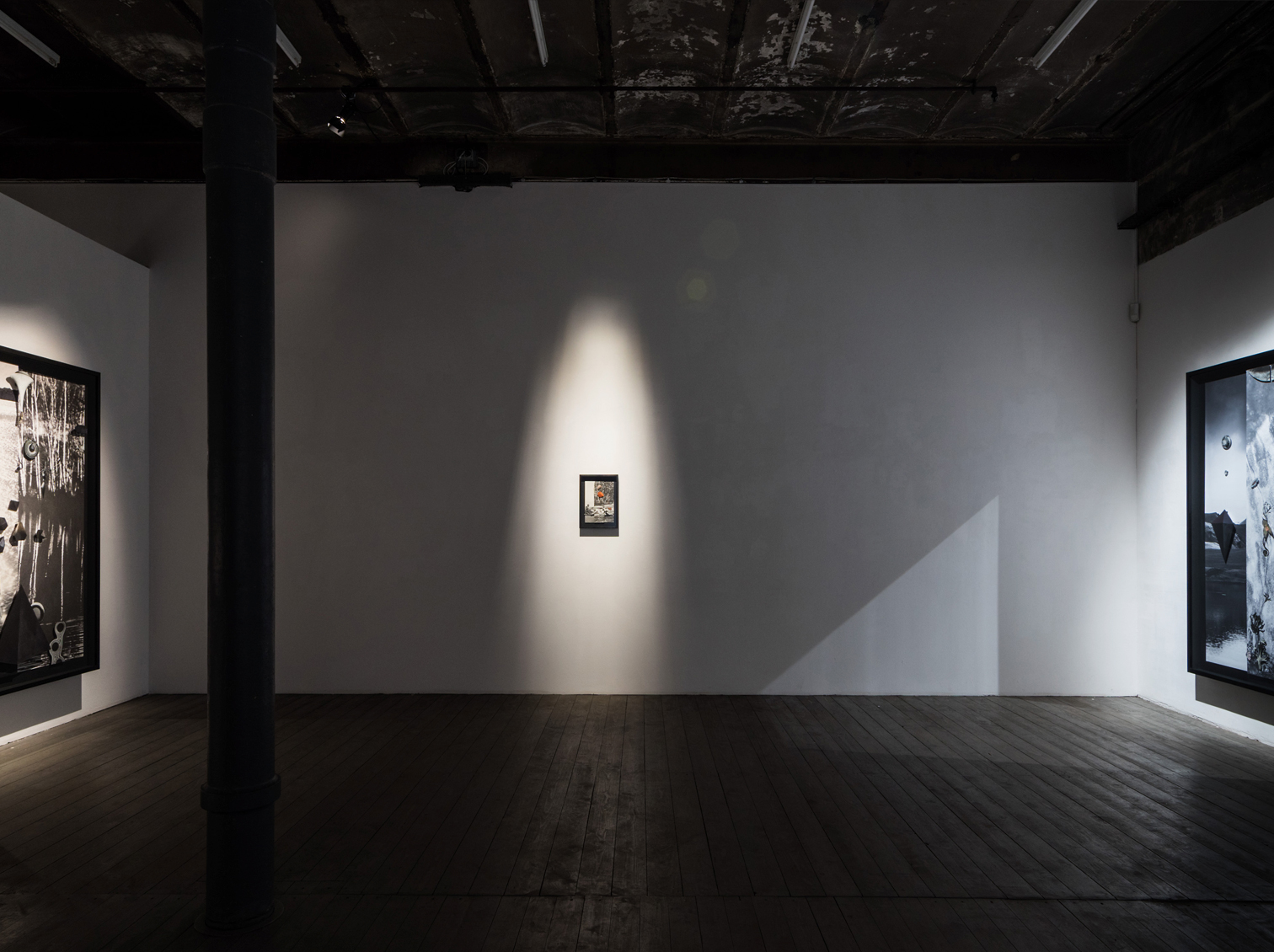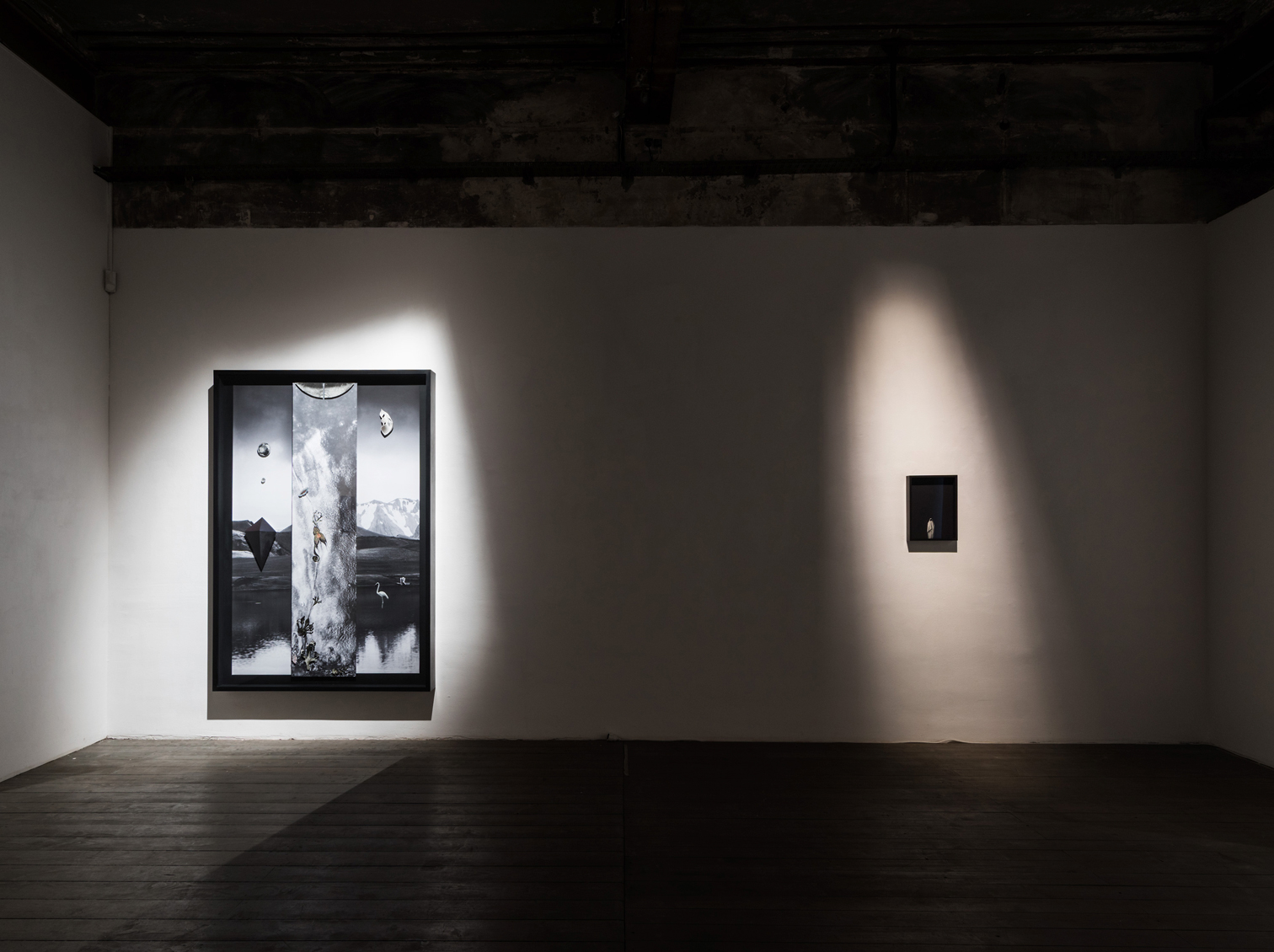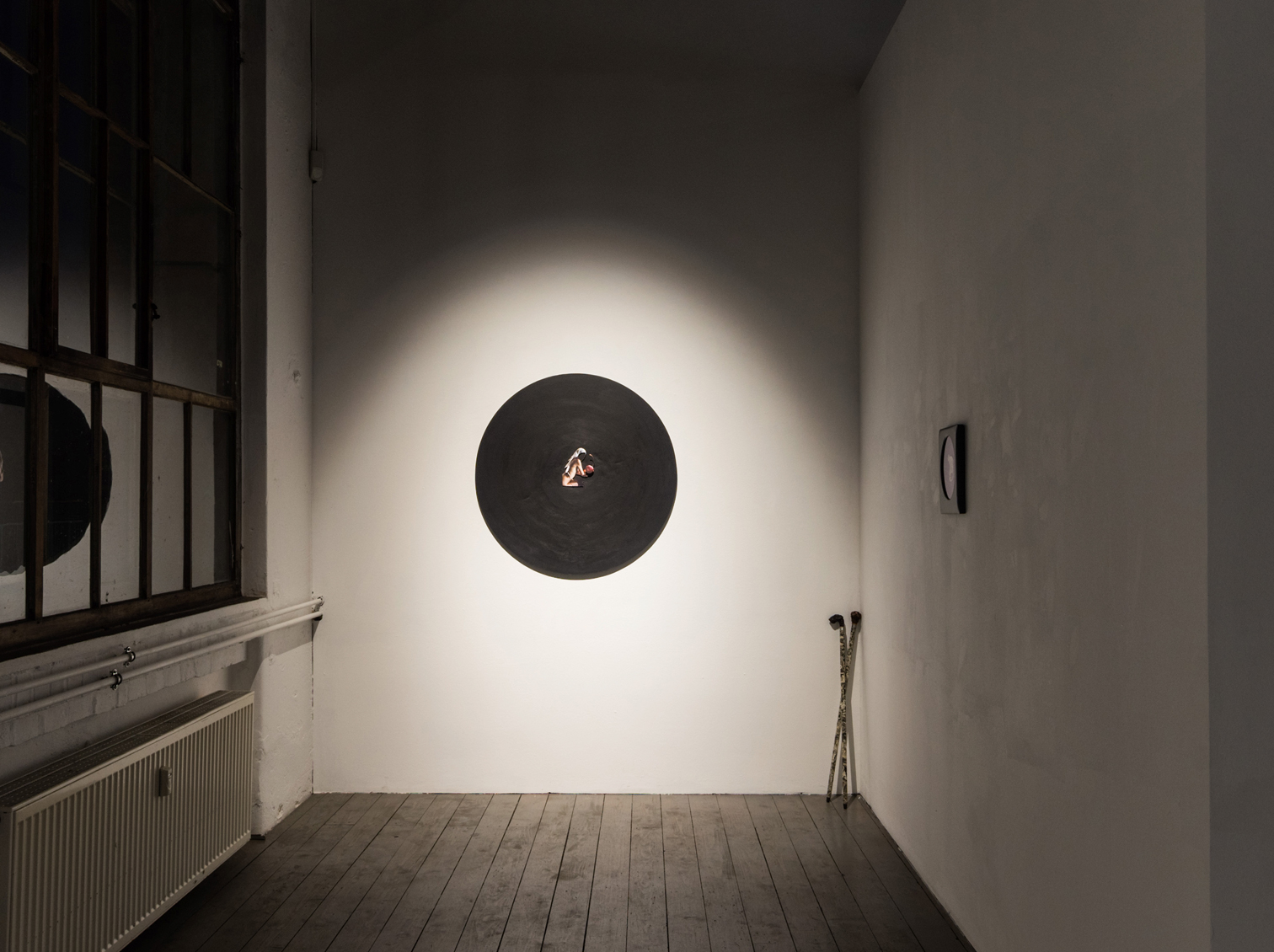Installation view: Das All / Photo: Georg Brueckmann
VON DER IDEE ZUM BILD
Spiel, Symbol und Fest *1
Das All – neue Arbeiten von Elisabeth Ehmann
Text von Esther Niebel, Oktober 2018
Es ist alles da: übervoll, überbordend, überquellend. Aber die Fülle ist geordnet, wohlüberlegt, sie ist kein Chaos, kein Tohuwabohu. Und auch wenn das Auge zunächst überwältigt ist, weil es so viele Angebote bekommt, legt sich die Orientierungslosigkeit, sobald man als Betrachter Mut gefasst hat. Der Entdeckergeist und -wille, der notwendig ist, um sich gegen die scheinbar willkürliche Fülle der Bilder zu behaupten, wird belohnt. Da ist ein leiser Rhythmus, gleichsam ein Takt, der ordnet, in Form bringt und allen Dingen, Steinen, Pflanzen, Tieren und Menschen einen Platz zuweist. Ihnen sagt, ob sie für sich alleine stehen, interagieren, melancholisch oder komisch sind. Bienen, Totenschädel, Mädchen, Vögel, Blumen, Blätter und Fische und immer wieder Fische. Alle wirken sie mit an der großen Choreografie des Lebens.
Und am Anfang war das Spiel: das Mineralische, das Pflanzliche, das Tierische und das Menschliche ist im Gleichgewicht, es interagiert, es schafft, es zeugt, es zerstört. Selbstbewegung ist der Grundcharakter des Lebendigen überhaupt. Ist das Lebendige ausgewogen, so beschränkt, fördert und erzeugt es sich selbst und die Protagonisten sich gegenseitig. Da wird selbst der Tod, ein Totenschädel, Fleisch, das zur Nahrung dient, schön, da es notwendiger Teil des Lebens ist. Jeder und Jedes ist Spieler, Mitspieler und Gegenspieler, so auch der Betrachter der intuitiv sich als Teil des Ganzen fühlt und in das Spiel mit hineingezogen wird. Aber vergessen wir das Spielerische nicht. Denn immer wenn es ernst wird, bedeutungsschwanger, kommt ein kleines Augenzwinkern: mal schwimmt eine kleine Giftflasche durch die schwere, schwarze See, mal gibt es eine unverhofft komische gymnastische Übung oder ein Haifisch bekommt Kunst-Haifischzähne, die ihn zur Karikatur seiner selbst mutieren lassen.
„Rose is a rose is a rose is a rose.“ *2 Der Fisch ist ein Fisch ist ein Fisch und ist doch mehr als ein Fisch. Die Biene ist nicht nur ein Tier, das sich zoologisch abbilden und beschreiben lässt. Sie wird mit Fleiß assoziiert, sie sammelt Honig, fliegt von Blüte zu Blüte. Bei dem Kirchenvater Ambrosius wird sie zum Symbol der honigsüßen Sprache. Auf die vier Elemente bezogen symbolisiert die Biene das Feuer, der Fisch das Wasser, der Schmetterling die Luft und die Schlange die Erde. Die ursprüngliche Bedeutung des Wortes Symbol bezog sich auf eine Erinnerungsscherbe. Zwei Menschen, die getrennt wurden, behielten je einen Teil der Scherbe bei sich, um sich des anderen zu erinnern. Nur gemeinsam konnten sie die Scherbe wieder zu einem Ganzen machen. Also kann man sagen, dass das was die sinnliche Erscheinung ausmacht, was man sehen, hören und riechen kann, untrennbar mit der geistigen Ebene, die sich nicht sofort offenbart, verbunden ist. Dennoch ist diese Ebene permanent präsent, bewusst oder unbewusst. Das ist der Nexus, der alles verbindet, der tief eingepflanzt ist und das gegenständliche Sehen mit dem geistigen sich orientierend verbindet.
„Wenn etwas mit der Erfahrung des Festes verknüpft ist, dann ist es dies, dass es jede Isolierung des einen gegenüber des anderen verweigert. Das Fest ist Gemeinsamkeit und ist die Darstellung der Gemeinsamkeit selbst in ihrer vollendeten Form. Fest ist immer für alle.“ *3
Das Fest ist die Überhöhung und damit die Herausnahme aus dem Alltäglichen, das Fest steht für sich selbst und ist nicht zweckgebunden. Das Fest ist zeitlich begrenzt und dennoch entsteht die Zeitordnung historisch gesehen erst durch die kalendarische Wiederkehr der Feste. Somit bekommt das Fest eine Doppelbedeutung in Bezug auf das Zeitliche: zum einen steht es für die ewige Wiederkehr, die Wiederholung, zum anderen für ein zeitliches Kontinuum, für den linearen Zeitbegriff, der ein Anfang und ein Ende kennt und damit die Spur der Dialektik in das Paradies schlägt. Zunächst ist Elisabeth Ehmann Jäger und Sammler. Sie ist auf der Suche nach Quellen, nach Vorlagen, nach Elementen, die ihr interessant erscheinen und die es verdient haben, ein neues Leben zu beginnen: Naturdarstellungen von Ernst Haeckel, Werke von Picasso und Matisse, ägyptische, griechische und etruskische Skulpturen, Gymnastinnen nach Art des Monte Verità, Alice im Wunderland, Momos schwarze Männer, die ganze Botanik und Tierwelt des Alexander von Humboldt, Schnipsel aus Modemagazinen, Kochbücher, alles wird aus seinem funktionalen Kontext genommen und verarbeitet. Das ein oder andere Fragment wird in einen neuen Sinnzusammenhang gestellt, wird anekdotisch oder surreal. Ein andermal besteht die neue Freiheit des Schnipsels einfach in der Schönheit an und für sich. Damit unterscheiden sich die Kollagen von Elisabeth Ehmann von denen der Surrealisten oder Dadaisten. Es sollen keine dunklen Bilder evoziert werden, keine paradoxen archaischen Urbilder entstehen. Elisabeth Ehmann vermittelt mit ihren Bildern das Bewusstsein, dass die Natur und der Kosmos größer sind als sie. Weder sie noch der Betrachter können diese wirklich erfassen und manchmal ist es das Weiseste einfach der Schönheit zu lauschen.
1 Spiel, Symbol und Fest sind Grundkategorien, die Hans Georg Gadamer in Die Aktualität des Schönen in Bezug auf Ästhetik und Kunst untersucht.
2 aus Gertrude Stein Sacred Emily, 1913
3 siehe H.-G. Gadamer in Die Aktualität des Schönen, Reclam, Stuttgart, S. 52
Play, symbol and festival
Das All (The Everything) – new works by Elisabeth Ehmann
Text by Esther Niebel, Leipzig, October 2018,
Translation by Susanne Olbrich, Berlin, October 2018
Everything is present: overflowing, abundant, profuse. This is an arranged bounty, deliberate – not chaotic, not tohubohu. It’s difficult to know where to look, but when the viewer takes courage, disorientation subsides. If approached in the spirit of discovery, with the will to look beyond the seemingly arbitrary, the viewer will have their reward. There is a subtle rhythm here, a beat that brings order and shape, that assigns a place to all things, to stones, plants, animals, and humans. It tells them whether they will stand alone or interact, whether they are melancholic or comical. Bees, skulls, girls, birds, flowers, leaves, and fish – again and again, fish. They all play their part in the choreography.
In the beginning was the game – the ‘play’ – when the mineral, plant, animal, and human elements were in balance. The play creates and destroys. Self-motion is the essential state of all that is living: creation, regeneration, and limitation in harmony, so that even death is beautiful. A skull, and the flesh that serves as sustenance, is a vital part of the cycle of life. Here everybody is a player (a participant, a contender), including the viewer, who becomes a part of the play. And let’s not forget playfulness – when things become serious, there’s a wink: a little bottle marked ‘poison’, floating across the heavy, black sea; an unexpectedly funny athletic tumble; a shark with false shark teeth that mutates into caricature.
Rose is a rose is a rose is a rose . Fish is a fish is a fish is a fish, and yet it’s more. The bee is not just its scientific classification: it is hard work, to Father Ambrose, mellifluous language, and it is fire – just as the fish is water, the butterfly air, and the snake, earth. Originally, the meaning of the word symbol related to a token of remembrance; those separated kept half of a divided object, fragments by which to remember each other. Only when reunited, they were able to fit the two pieces together and form a whole. The realm of the senses cannot be separated from the unseen, the intuitive – the spiritual. It is this connection, deeply rooted in our psyches, that pairs the real with the mysterious.
“If there is something connected with the experience of the festival, then it is this that it denies any isolation one over the other. The festival is commonality and is the depiction of the commonality itself in its most accomplished form. The festival is for everyone always.” The festival is not an everyday occurrence, it is exaggeration; the festival represents only itself and cannot be recreated; the festival is for a limited time only – the festival will be endlessly repeated. On the one hand the festival stands for the eternal return, on the other it refers to a temporal continuum that knows a beginning and an end, a linear concept of time, thus linking the investigation to the idea of paradise.
In the first instance, Elisabeth Ehmann is a hunter and collector in search of sources, elements she feels deserve to begin a new life: representations by Ernst Haeckel, works by Picasso and Matisse, Egyptian, Greek, and Etruscan sculptures, gymnasts à la Monte Verità, Alice in Wonderland, Momo’s Men in Grey, the entire flora and fauna of Alexander von Humboldt, cuttings from fashion magazines, cookery books, everything gets taken out of context to be reprocessed. Fragments are rearranged – anecdotally or fantastically. The cutting is free to be beautiful in the abstract. This means that Elisabeth Ehmann’s collages differ from those of the Surrealists or Dadaists. No dark images should be perceived; no paradoxical out-dated archetypes triggered. Ehmann conveys the awareness that nature and the universe are bigger than her; though neither Ehmann nor those who behold her work can grasp this – wiser, then, to surrender to her work’s beauty.
+ + + + + + +
Elisabeth Ehmann work is based on collage. Working on paper and more sculptural objects, Ehmann renders abstract compositions by the use of structural elements. Her colourful archive is taken out of photographic magazines and catalogues, abandoned books she collects. The artists meticulously cut, dissects glossy products out of our consumption goods, rearranging them until only fragment remains. Ehmann seeks to underline the ephemeral nature and variability of these flimsy values, aiming to regenerate/repair the condition of the material into compound complex structures.

